Rate Optimization of Two-Way Relaying with Wireless Information and Power Transfer
Abstract
:1. Introduction
1.1. Related Works
1.2. Motivation and Contribution
2. System Model and Rate Performance
2.1. System Model
2.2. Achievable Rate Region
3. Rate-Optimal Resource Allocation
3.1. Resource Allocation for the PS-SWIPT
3.2. Resource Allocation for the TS-SWIPT
4. Numerical Results
5. Conclusions
Acknowledgments
Author Contributions
Conflicts of Interest
Appendix A
References
- Al-Fuqaha, A.; Guizani, M.; Mohammadi, M.; Aledhari, M.; Ayyash, M. Internet of Things: A survey on enabling technologies, protocols, and applications. IEEE Commun. Surv. Tutor. 2015, 17, 2347–2376. [Google Scholar] [CrossRef]
- Baler, T.; Asim, M.; Tawfik, H.; Aldawsari, B.; Buyya, R. An energy-aware service composition algorithm for multiple cloud-based IoT applications. J. Netw. Comput. Appl. 2017. [Google Scholar] [CrossRef]
- Baker, T.; Al-Dawsaria, B.; Tawfik, H.; Reid, D.; Ngoko, Y. GreeDi: Anenergy efficient routing algorithm for big data on cloud. Ad Hoc Netw. 2015. [Google Scholar] [CrossRef]
- Aldawsari, B.; Baker, T.; England, D. Trusted energy-efficient cloud-based services brokerage platform. Int. J. Intell. Comput. Res. 2015, 6, 630–639. [Google Scholar] [CrossRef]
- Lu, X.; Wang, P.; Niyato, D.; Kim, D.I.; Han, Z. Wireless networks with RF energy harvesting: A contemporary survey. IEEE Commun. Surv. Tutor. 2015, 17, 757–789. [Google Scholar] [CrossRef]
- Jayakody, D.N.K.; Thompson, J.; Chatzinotas, S.; Durrani, S. Wireless Information and Power Transfer: A New Green Communications Paradigm; Springer-Verlag: New York, NY, USA, 2017. [Google Scholar]
- Chen, L.; Chen, W.; Wang, B.; Zhang, X.; Chen, H.; Yang, D. System-level simulation methodology and platform for mobile cellular systems. IEEE Commun. Mag. 2011, 49, 149–155. [Google Scholar]
- Wang, J.; YuWen, O.; Chen, H.; Li, S. Power allocation between pilot and data symbols for MIMO systems with MMSE detection under MMSE channel estimation. EURASIP J. Wirel. Commun. Netw. 2011, 2011, 785437. [Google Scholar] [CrossRef]
- Wang, C.; Chen, H.; Yin, Q.; Feng, A.; Molisch, A.F. Multi-user two-way relay networks with distributed beamforming. IEEE Trans. Wirel. Commun. 2011, 10, 3460–3471. [Google Scholar] [CrossRef]
- Li, Y.; Yin, Q.; Sun, L.; Chen, H.; Wang, H. A channel quality metric in opportunistic selection with outdated CSI over Nakagami-m fading channels. IEEE Trans. Veh. Technol. 2012, 61, 1427–1432. [Google Scholar] [CrossRef]
- Nasir, A.A.; Zhou, X.; Durrani, S.; Kenedy, R.A. Relaying protocols for wireless energy harvesting and information processing. IEEE Trans. Wirel. Commun. 2013, 12, 3622–3636. [Google Scholar] [CrossRef]
- Chen, Z.; Xia, B.; Liu, H. Wireless information and power transfer in two-way amplify-and-forward relaying channels. In Proceedings of the IEEE Global Conference Signal and Information Processing, Atlanta, GA, USA, 3–5 December 2014; pp. 168–172. [Google Scholar]
- Liu, Y.; Wang, L.; Elkashlan, M.; Duong, T.Q.; Nallanathan, A. Two-way relaying networks with wireless power transfer: Policies design and throughput analysis. In Proceedings of the IEEE Global Communication Conference, Austin, TX, USA, 8–12 December 2014; pp. 4030–4035. [Google Scholar]
- Tutuncuoglu, K.; Varan, B.; Yener, A. Throughput maximization for two-way relay channels with energy harvesting nodes: The impact of relaying strategies. IEEE Trans. Commun. 2015, 63, 2081–2093. [Google Scholar] [CrossRef]
- Fang, Z.; Yuan, X.; Wang, X. Distributed energy beamforming for simultaneous wireless information and power transfer in the two-way relay channel. IEEE Signal Process. Lett. 2015, 22, 656–660. [Google Scholar] [CrossRef]
- Gu, Y.; Aïssa, S. RF-based energy harvesting in decode-and-forward relaying systems: Ergodic and outage capacities. IEEE Trans. Wirel. Commun. 2015, 14, 6425–6434. [Google Scholar] [CrossRef]
- Ju, M.C.; Kang, K.M.; Hwang, K.S.; Jeong, C. Maximum transmission rate of PSR/TSR protocols in wireless energy harvesting DF-based relay networks. IEEE J. Sel. Areas Commun. 2015, 35, 2701–2717. [Google Scholar] [CrossRef]
- Mishra, D.; De, S.; Chiasserini, C.F. Joint optimization schemes for cooperative wireless information and power transfer over Rician channels. IEEE Trans. Commun. 2016, 64, 554–571. [Google Scholar] [CrossRef]
- Liu, H.; Kim, K.J.; Kwak, K.S.; Poor, H.V. Power splitting based SWIPT with decode and forward full-duplex relaying. IEEE Trans. Wirel. Commun. 2016, 15, 7561–7577. [Google Scholar] [CrossRef]
- Salem, A.; Hamdi, K.A. Wireless power transfer in multi-pair two-way AF relaying networks. IEEE Trans. Commun. 2016, 64, 4578–4591. [Google Scholar] [CrossRef]
- Sacarelo, G.; Thi Le, T.V.; Kim, Y.H. Resource allocation for wireless powered multi-pair massive antenna relaying with zero-forcing beamforming. IEEE Commun. Lett. 2016, 20, 2316–2319. [Google Scholar] [CrossRef]
- Wang, S.; Xia, M.; Wu, Y. Multipair two-way relay network with harvest-then-transmit users: Resolving pairwise uplink-downlink coupling. IEEE J. Sel. Top. Signal Proc. 2016, 10, 1506–1521. [Google Scholar] [CrossRef]
- Nguyen, D.K.; Jayakody, D.N.K.; Chatzinotas, S.; Thompson, J.S.; Li, J. Wireless energy harvesting assisted two-way cognitive relay networks: Protocol design and performance analysis. IEEE Access 2017. [Google Scholar] [CrossRef]
- Lee, H.; Song, C.; Choi, S.H.; Lee, I. Outage probability analysis and power splitter designs for SWIPT relaying systems with direct link. IEEE Commun. Lett. 2017, 21, 648–651. [Google Scholar] [CrossRef]
- Do, T.P.; Song, I.; Kim, Y.H. Simultaneous wireless transfer of power and information in a decode-and-forward two-way relaying network. IEEE Trans. Wirel. Commun. 2017, 16, 1579–1692. [Google Scholar] [CrossRef]
- Rajaram, A.; Jayakody, D.N.K.; Srinivasan, K.; Chen, B.; Sharma, V. Opportunistic wireless power transfer scheme for multiple access relay networks. IEEE Access 2017. [Google Scholar] [CrossRef]
- Ciuonzo, D.; Rossi, P.S.; Dey, S. Massive MIMO channel-aware decision fusion. IEEE Trans. Signal Process. 2015, 63, 604–619. [Google Scholar] [CrossRef]
- Shirazinia, A.; Dey, S.; Ciuonzo, D.; Rossi, P.S. Massive MIMO for decentralized estimation of a correlated source. IEEE Trans. Signal Process. 2016, 64, 2499–2512. [Google Scholar] [CrossRef]
- Zhou, X.; Zhang, R.; Ho, C.K. Wireless information and power transfer: Architecture design and rate-energy tradeoff. IEEE Trans. Commun. 2013, 61, 4754–4767. [Google Scholar] [CrossRef]
- Shim, Y.; Park, H. A closed-form expression of optimal time for two-way relay using DF MABC protocol. IEEE Commun. Lett. 2014, 18, 721–724. [Google Scholar] [CrossRef]
- Pang, L.; Zhang, Y.; Li, J.; Ma, Y.; Wang, J. Power allocation and relay selection for two-way relaying systems by exploiting physical layer network coding. IEEE Trans. Veh. Technol. 2014, 63, 2723–2730. [Google Scholar] [CrossRef]
- Kim, S.H.; Jung, B.C.; Sung, D.K. Transmit power optimization for two-way relay channels with physical layer network coding. IEEE Commun. Lett. 2015, 19, 151–154. [Google Scholar] [CrossRef]
- Do, T.P.; Kim, Y.H. Outage-optimal power and time allocation for rate-aware two-way relaying with a decode-and-forward protocol. IEEE Trans. Veh. Technol. 2016, 65, 9673–9686. [Google Scholar] [CrossRef]
- Tse, D. Fundamentals of Wireless Communications; Cambridge University Press: Cambrige, UK, 2005; pp. 228–232. ISBN 978-0-521-84527-4. [Google Scholar]
- Boyd, S.; Vandenberghe, L. Convex Optimization; Cambridge University Press: Cambridge, UK, 2004; pp. 89–91. ISBN 978-0-521-83378-3. [Google Scholar]
- Potra, F.A.; Wright, S.J. Interior-point methods. J. Comput. Appl. Math. 2000, 124, 281–302. [Google Scholar] [CrossRef]
- Löfberg, J. YALMIP : A Toolbox for Modeling and Optimization in MATLAB. In Proceedings of the CACSD Conference, New Orleans, LA, USA, 2–4 September 2004; pp. 284–289. [Google Scholar]
- Xue, J.; Sellathurai, M.; Ratnarajah, T.; Ding, Z. Performance analysis for multi-way relaying in Rician fading channels. IEEE Trans. Commun. 2015, 63, 4050–4062. [Google Scholar] [CrossRef]
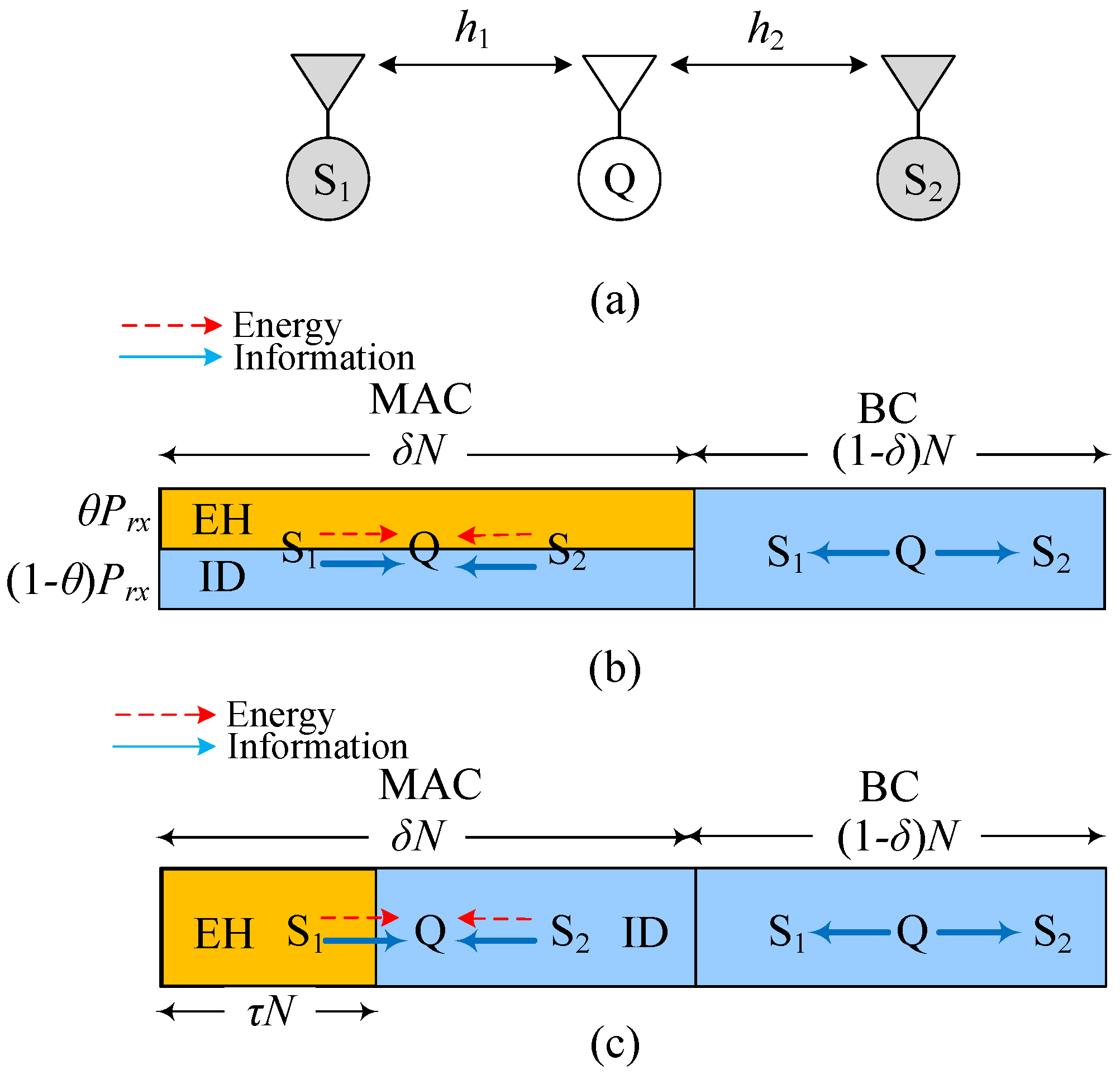
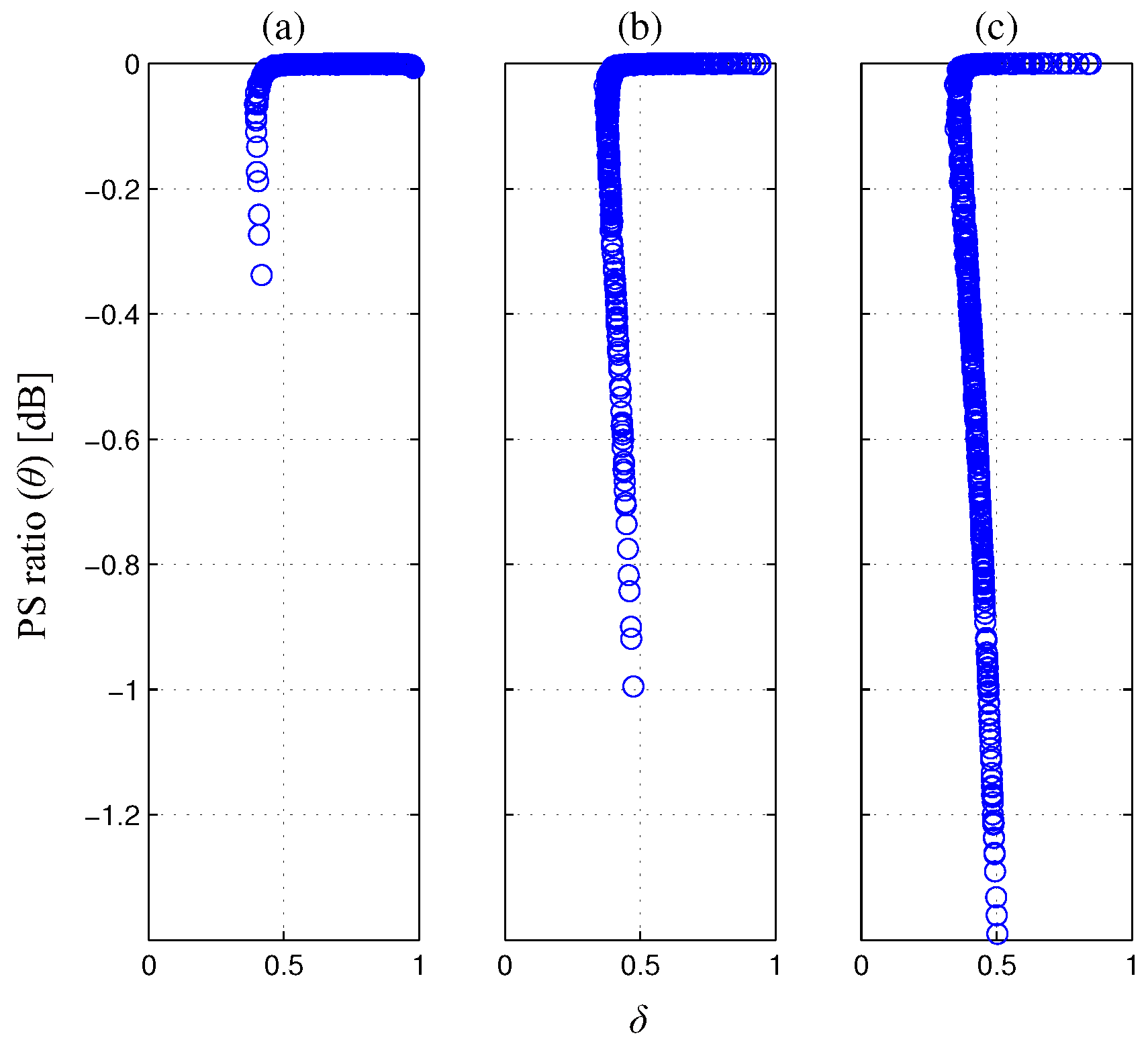
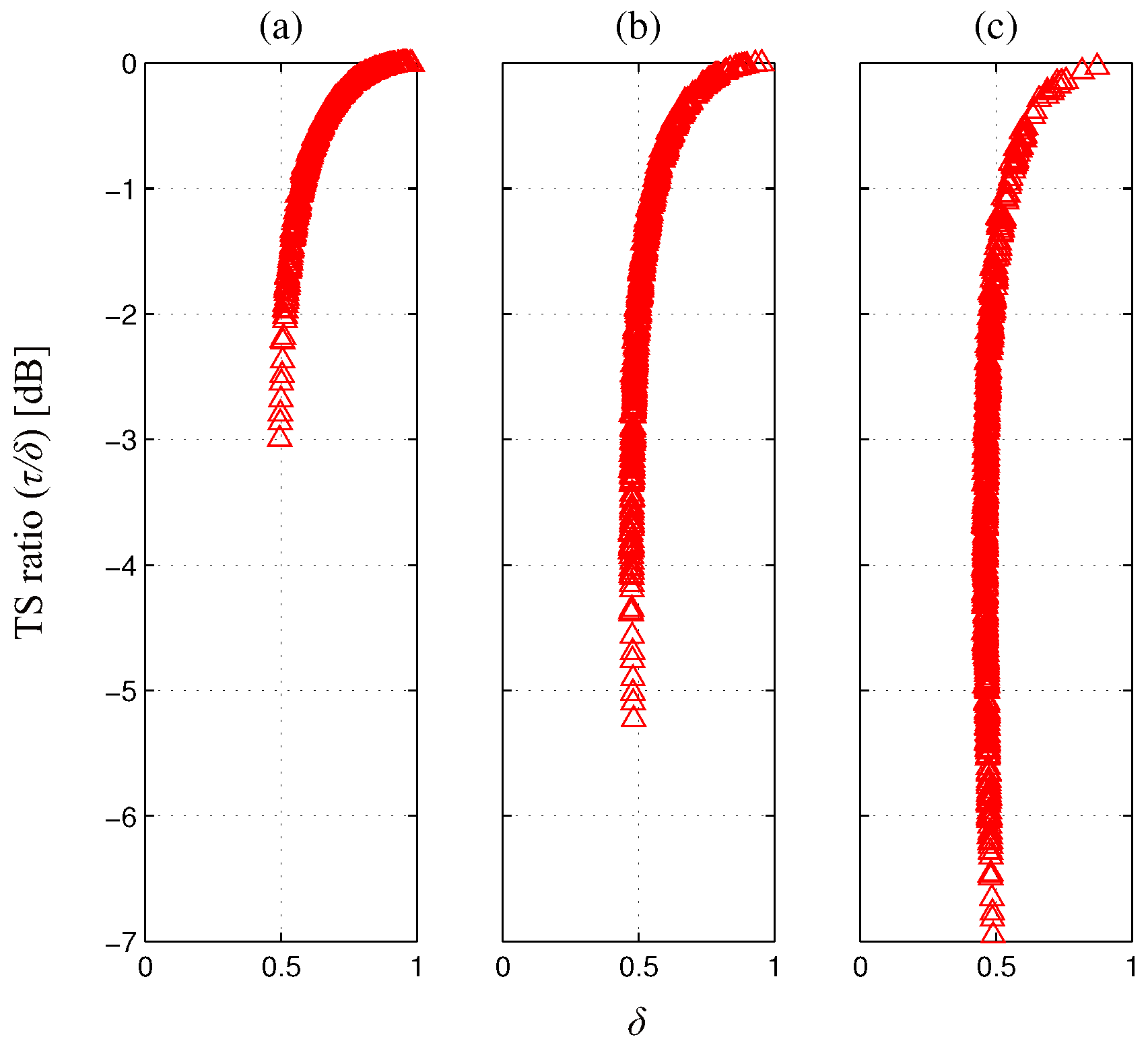
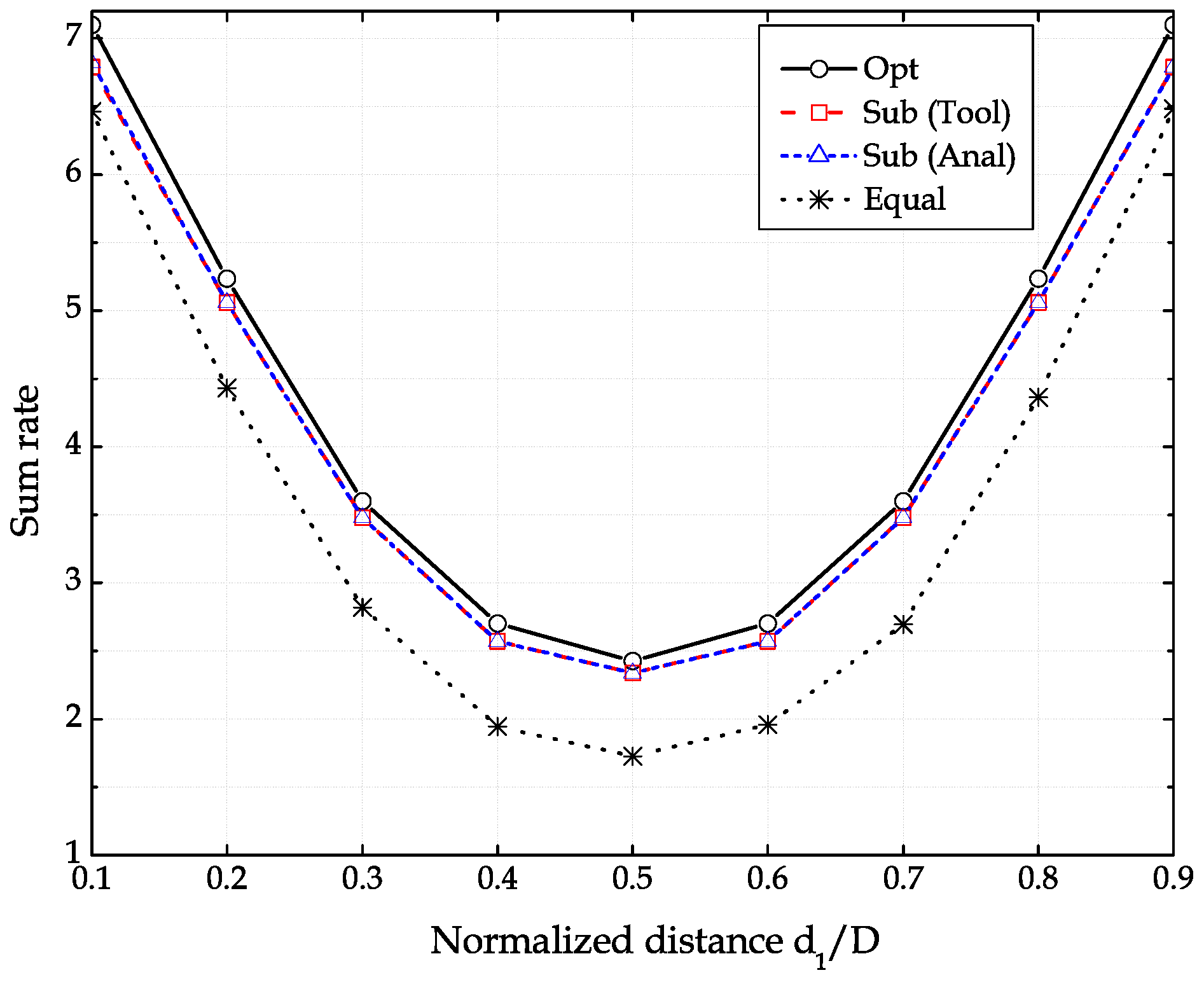
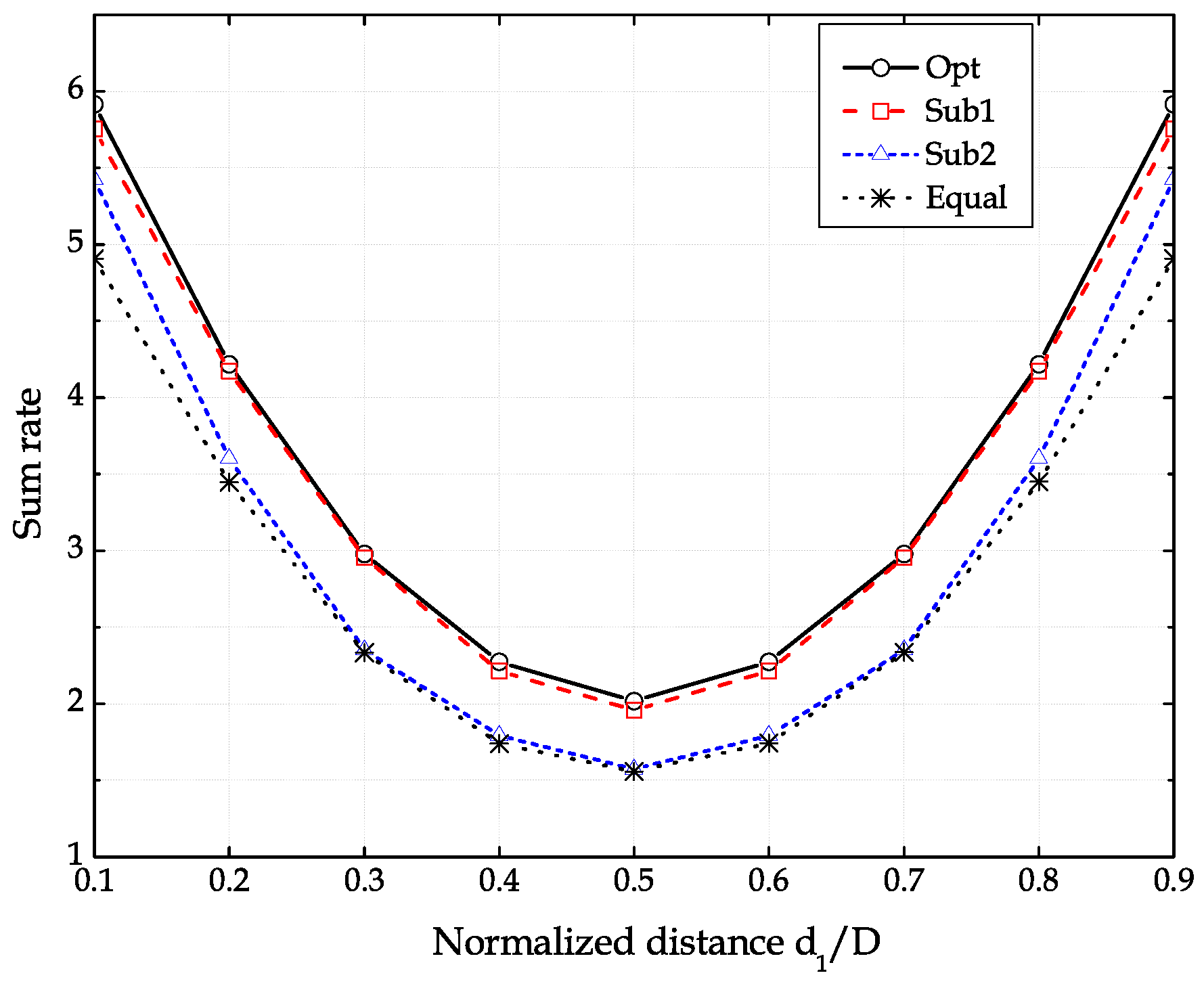
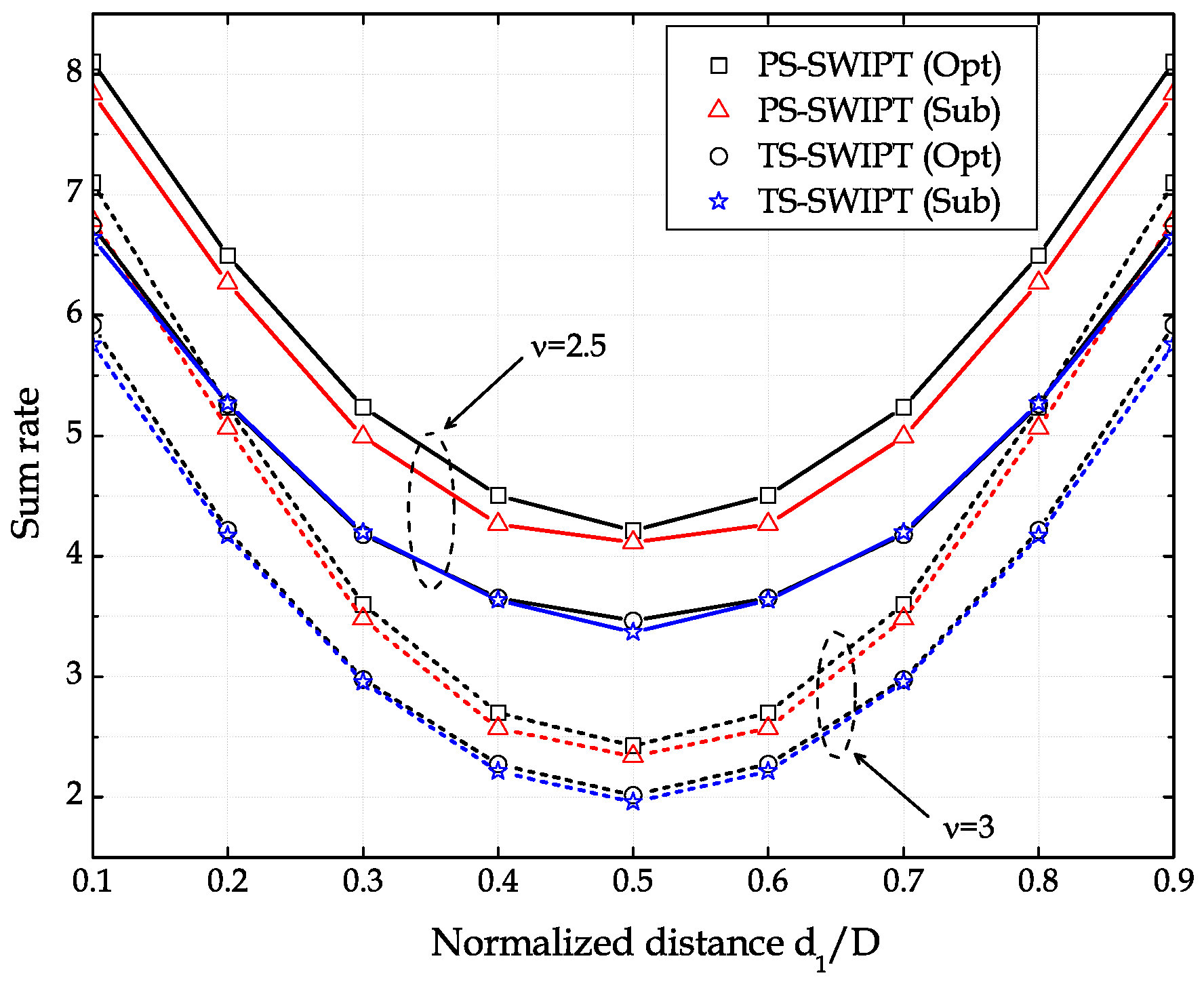
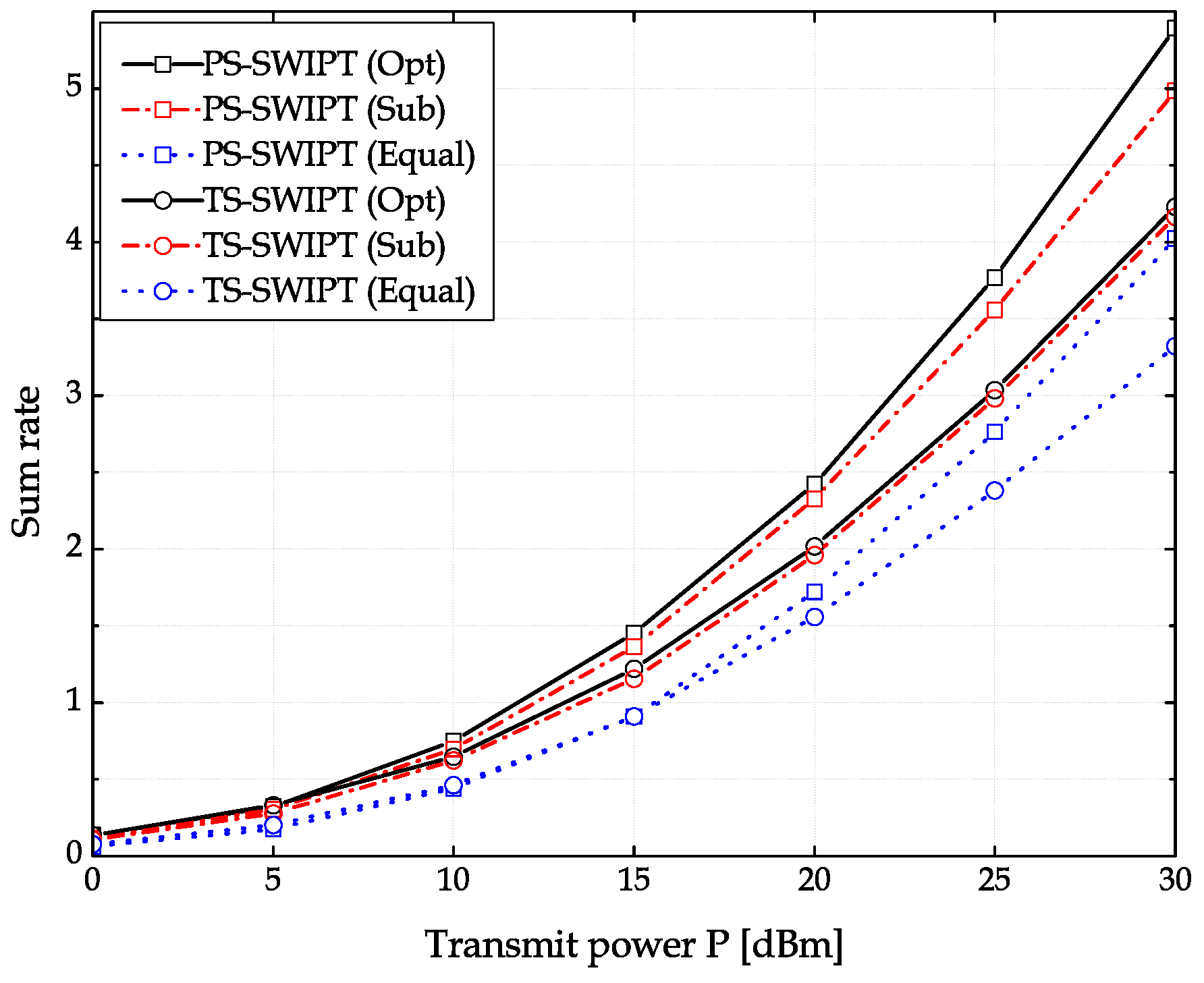
© 2017 by the authors. Licensee MDPI, Basel, Switzerland. This article is an open access article distributed under the terms and conditions of the Creative Commons Attribution (CC BY) license (http://creativecommons.org/licenses/by/4.0/).
Share and Cite
Do, T.P.; Jeong, Y.; Kim, Y.H. Rate Optimization of Two-Way Relaying with Wireless Information and Power Transfer. Information 2017, 8, 141. https://doi.org/10.3390/info8040141
Do TP, Jeong Y, Kim YH. Rate Optimization of Two-Way Relaying with Wireless Information and Power Transfer. Information. 2017; 8(4):141. https://doi.org/10.3390/info8040141
Chicago/Turabian StyleDo, Thinh Phu, Yeonjin Jeong, and Yun Hee Kim. 2017. "Rate Optimization of Two-Way Relaying with Wireless Information and Power Transfer" Information 8, no. 4: 141. https://doi.org/10.3390/info8040141




